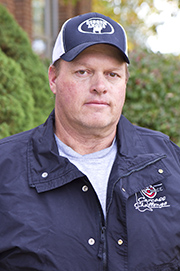
ASCC winds up four-year demo
By Steve Suther
The commercial Angus world warmed to the concept of AngusSource®, with more cattle enrolled each year from 2008 through 2011. During those years, the AngusSource Carcass Challenge (ASCC) saw entries totaling 6,188 with 58.3% accepted for the Certified Angus Beef ® (CAB®) brand; nearly 13% of the total made USDA Prime, according to Ginette Kurtz, AngusSource manager.
Over the past 20 years, several carcass value demonstration contests have showcased high-quality commercial Angus cattle that can hit the CAB target, going back to the Value Discovery Project, Best of the Breed and National Angus Carcass Challenge.
Those programs assigned dollar value to carcass merit, but in light of varying grids and seasonality, the ASCC simply ranked pens on ability to hit the CAB target. Tiebreakers came down to cutability comparisons.
“The goal was to build relationships with feedyards that are feeding AngusSource calves, accumulate harvest data on them and facilitate the transfer of information back to cow-calf producers,” Kurtz says. Along the way, we demonstrated that pens of Angus cattle really can hit 100% CAB.”
Twelve CAB partner feedlots participated, with a relatively few 22 distinct owners of entries across the four years. There were 40 ranches of origin from West Virginia to Oregon and Louisiana to Montana, 13 states in all.
The first year’s results showed excellent quality with the Beller Feedlot, Lindsay, Neb., winning pen of 62 Montana steers making 80.7% CAB and Prime. They also fed the third-place pen that made 68.2%. Competing cousins at the nearby Beller Corporation came in second with Nebraska steers that went 69.1% CAB; and fourth went to Cattleman’s Choice Feedyard, Gage, Okla., which partnered with Jimmy Taylor of Cheyenne, Okla., on the 67.7% CAB steers.
Before the contest would end, Beller Feedlot would account for more than half of all entries, with 3,202 head.
Two veterans of the Angus carcass contests sparred in year two. Mike Kasten, Millersville, Mo., who would end up enrolling 273 head at Irsik & Doll Feed Yard, Garden City, Kan., over three years, started 2009 with steers making 90.5% CAB. That edged out Mason Fleenor of Ida Grove, Iowa, at 90.2% CAB, but Fleenor would hit 92.7% CAB the next year.
However, a little-known farmer feeder at Savannah, Mo., would quietly miss those upper levels with only 80% CAB to start 2008. But John Osborn would be back, again and again. His 474 calves from a pool of known Angus genetics set records of 92.3% and 92.5% CAB in 2009 to win the ASCC, one of those groups achieving 36% CAB Prime.
By the time 2010 drew to a close, everybody knew all of Osborn’s 521 enrollments were exceptional. There was other news, as the University of Missouri’s Thompson Farm, Spickard, Mo., showed what the steer mates of Show-Me Heifers could do, pushing toward 87% CAB.
But dozens of other producers with cattle hitting 70%, 80% and 90% CAB could only watch in wonder as two of the Osborn Farms entries made 100% CAB; they shook their heads as one steer in the third-place entry did not make CAB, but 61.5% of them achieved CAB Prime.
For 2011, the notables were again Mike Kasten at 81.6% CAB, the University of Missouri with 89.5% CAB, and Beller Feedlot’s 84.2% CAB cattle from veteran contender Jimmy Thomas of Adrian, Ore. Of course, the last annual $500 prize and winner’s jacket went to John Osborn, even though his numbers were down with just 154 head in four pens, and the championship pen mustered “only” 92.1% CAB and Prime.

“It was a good run,” Kurtz says. “Grid premiums out there today mean producers can earn their own rewards in the real-world market, and AngusSource enrollment is still a great way to start.”
You may also like
Drought Impact and Cattle Industry Dynamics
As drought conditions persist across much of cattle country, farmers and ranchers are at a pivotal juncture in the cattle industry’s landscape. What impact does this prolonged dry spell have on the nation’s herd numbers? When will heifer retention begin? How will industry dynamics influence the spring bull sale season?
Nebraska Ranch Receives Certified Angus Beef Commercial Award
Troy Anderson, managing a Nebraska ranch, focuses on breeding thriving maternal cows that will grade premium Choice and Prime, while respecting livestock, people and land. Anderson Cattle receives the 2023 CAB Commitment to Excellence Award. Their journey includes improving genetics, feeding home-raised and purchased calves and using data for better breeding decisions, all with a bottom-line approach.
Magnum Feedyard Earns Certified Angus Beef Award
While Magnum hasn’t always had pens filled with Angus-influenced cattle, they’ve invested in infrastructure, improved quality-based marketing and sought better genetics. Their dedication to detail and employee appreciation drive their success to high-quality beef production.



